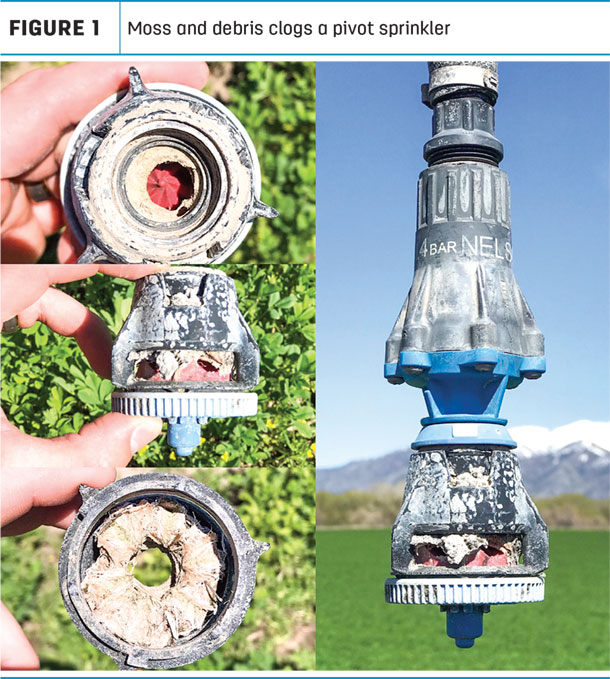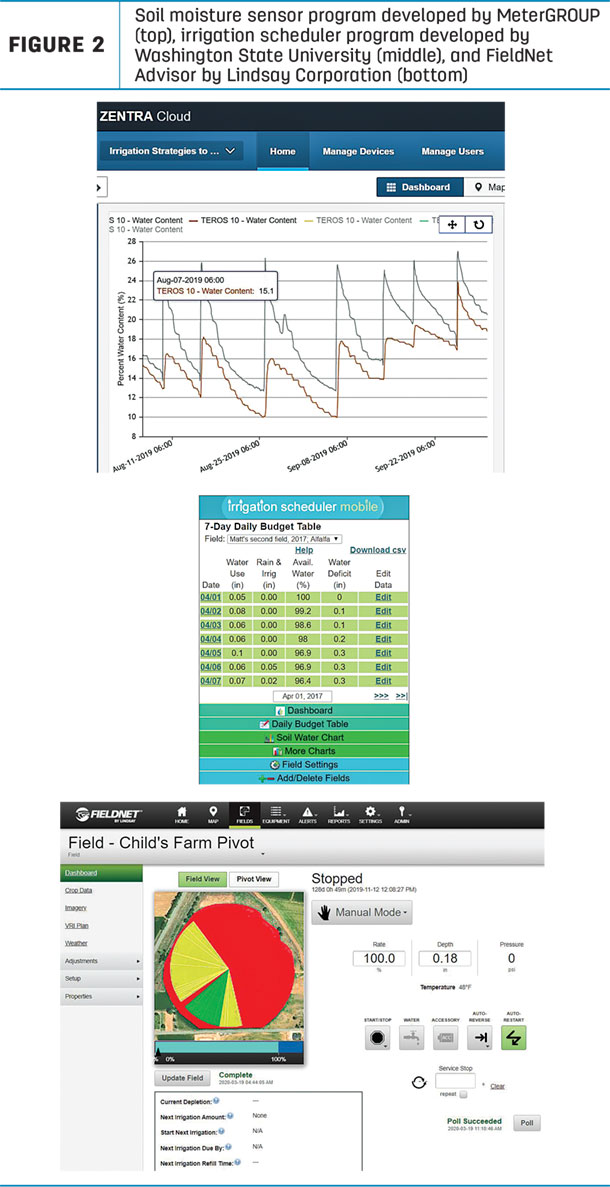How would you answer this question: “Which equipment returns more profit on your farm – your tractors or your sprinklers?” The answer was almost unanimous at several recent extension crop schools through Utah: “Sprinklers.” Now, for the more difficult question: “Which one do you treat better?”
Superb tractor maintenance is a given on most farms, but sprinklers can more easily be neglected.
Irrigation as high priority
In reality, both tractors and sprinklers are critical to most farm operations, and the answer could become quite involved and complicated. The point is: Sprinklers are a crucial piece of machinery on irrigated farms, and their maintenance and care should be a high priority.
Irrigation can be one of the most challenging inputs to manage in forage production because it requires constant adaptation to weather conditions and usually involves at least eight to 10 decisions each season about the timing and amount of irrigation to apply. In addition to these complexities, alfalfa does not always receive the “irrigation attention” it needs, perhaps because it is perceived as a crop that tolerates drought and difficult growing conditions well, and focus or efforts are sometimes shifted to other crops perceived as more lucrative.
Consistent feedback from several recent workshops and field days with extension, irrigation professionals and crop advisers confirm these challenges and suggest that concentrated effort on irrigation maintenance and innovation should be a high priority for alfalfa and forage production.
Irrigation strategies
Multiple technologies and strategies for advanced irrigation exist, but investments and skill required for these strategies vary widely. One common approach to advanced irrigation is new pivot irrigation technologies such as low-elevation spray application (LESA), low-energy precision application (LEPA) nozzle systems and mobile drip irrigation (MDI). These technologies show promise and have documented increases in alfalfa yield through improved irrigation uniformity, coupled with frequent water savings. However, investments in new pivot technologies can sometimes be too large for some alfalfa growers to adopt these practices. Several other less-expensive strategies to improve irrigation management exist. Some of these include:
- Regular maintenance of irrigation systems (replacement of worn irrigation nozzles, pressure regulators and other equipment, Figure 1)

- Reducing irrigation rates to avoid slight overirrigation
- Advanced irrigation scheduling
While these irrigation strategies can be simple and straightforward, many growers still hesitate to use them, according to surveys conducted by the National Agricultural Statistics Service. Part of a grower’s hesitation in adopting some of these advanced irrigation practices might be related to sparse information on agronomic and economic gains that might be realized from these practices.
Prioritizing which method of irrigation and irrigation equipment management might improve alfalfa yield and quality will help growers improve their profits and deal with diminishing water supplies prevalent across the intermountain West.
Why schedule irrigation?
The short answer to why irrigation should be scheduled is because yield, forage quality and profit in irrigated agriculture are directly and heavily influenced by proper irrigation schedules. Arriving at the ideal irrigation schedules can, however, be quite complex and multifaceted. Some of the major benefits of irrigating with the proper frequency include:
- Optimizing production and profit
- Improving irrigation efficiency
- Decreasing excessive deep percolation below the root zone
- Decreasing runoff
Irrigation frequency options are sometimes limited by the timing of water availability and irrigation delivery systems. However, opportunities to refine irrigation schedules usually still exist for most applications. Irrigation rates can almost always be adjusted when using sprinklers, and irrigations can often be concentrated at critical times despite water schedule constraints.
How to schedule
Modifying irrigation schedules can be one of the simplest and most inexpensive ways to improve water management. The first step to selecting a schedule is water measurement and monitoring. The importance of this cannot be overstated. Inaccurate water measurements will thwart almost all other efforts to refine irrigation management. This can be as easy as measuring water volume in buckets placed under moving sprinklers to more accurate and continuous measurements with flow meters.
Irrigation schedules for sprinklers can usually be easily modified by changing flow rates, irrigation set lengths, nozzle size and other methods. The premise of selecting the right schedule is to apply rates or frequencies that do not exceed soil intake rates, do not exceed the maximum allowable soil water depletion between irrigations and meet crop water use or evapotranspiration (ET) demand. This approach will reduce or prevent runoff and unnecessary water losses.
Several methods exist for selecting irrigation schedules. Some of the major types include:
- Monitoring soil moisture by hand using the feel method or with a variety of soil moisture sensors. Many new soil moisture sensor companies have now developed ways to access soil moisture data remotely on a computer, phone or other device, making data more accessible than before. Utilizing this approach requires equipment purchase or rental, installation and maintenance, along with subscription costs for remote access of soil moisture data.
- Irrigation scheduler systems utilize weather data to estimate ET, calculate water balances and recommend irrigation schedules according to maximum allowable depletion for each soil type. The Washington State University Irrigation Scheduler is one of the widely available free programs in the Intermountain West (Irrigation scheduler mobile). Although it is a free application, it does require time to set up fields, input irrigation amounts and interpret and apply the schedules it recommends.
- Commercial scheduler programs that utilize crop growth models, soil characteristics and ET estimated from satellite or aerial imagery are also available mainly for use with pivot irrigation (Figure 2).

A few of the available programs and services, among many, include the FieldNet Advisor program by Lindsay Corporation and the variable-rate irrigation software by Crop Metrics. Many of these programs have the ability to send prescriptions directly to pivots for autonomous irrigation. They generally include subscription costs and time to set up fields, input crop management details and to apply schedules.
Cost of scheduling
“Advanced approaches to irrigation scheduling sound great, but can I really afford them on my farm?” While it is difficult to compare the cost of a large variety of scheduling approaches, we provide some general guidelines below for equipment costs (not including labor or inflation, which are highly variable).
Soil moisture sensing costs are highly dependent on what equipment and data access options you want, but generally plan on at least $3 per acre per year for these. The irrigation scheduler is a free application but does require frequent manual input of data. FieldNet Advisor currently costs roughly $4 per acre per year. As you explore these options, be sure to remember that returns (improved yield or quality, or reduced water and energy costs) from irrigation scheduling approaches need to outweigh the costs, and that you actually plan to adjust in your irrigation.
Recent research findings
The benefits of advanced irrigation approaches are intuitive; however, few research studies have documented how various irrigation schedules or sprinkler maintenance impacts alfalfa yield, forage quality and profits. In 2019, a team of Utah State University faculty partnered with irrigation industries and alfalfa growers in south-central Utah to begin answering these critical questions. On 12 alfalfa fields, each grower’s standard irrigation schedule (based mainly on their experience) was compared to the three other irrigation scheduling approaches shown in Figure 2. Reduced irrigation rates and new irrigation equipment (nozzles, heads and regulators) were also tested.
The key preliminary findings of this study in 2019 showed that:
- 10% reductions in irrigation rates rarely impacted alfalfa yield – only five of 37 (14%) cuts had reduced yield with less water, and reductions occurred in different fields for various cuts. This indicates opportunities to slightly cut back on irrigation without impacting production.
- Replacement of sprinklers ranging from three to 20 years old also rarely impacted yield – only four of 37 (11%) cuts had improved yield with new parts. This indicates sprinkler parts may last longer than anticipated.
- The advanced irrigation scheduling approaches had minor impacts on crop yield on 15 cuts but sometimes reduced irrigation rates by up to 5%. This indicates that irrigation scheduling may have more potential to save water than to improve yield.
Next steps
Use caution when interpreting the research results above; they represent only one season of data in a year that was wetter than average. This study will be repeated during the next two growing seasons to collect a more robust set of information about irrigation strategies that might make the most sense – from an agronomic and economic standpoint. What we can say so far is: There are opportunities to improve irrigation in ways that help save water without sacrificing production. ![]()
Earl Creech and Niel Allen are also with Utah State University Extension.

-
Matt Yost
- Utah State University Extension
- Email Matt Yost












